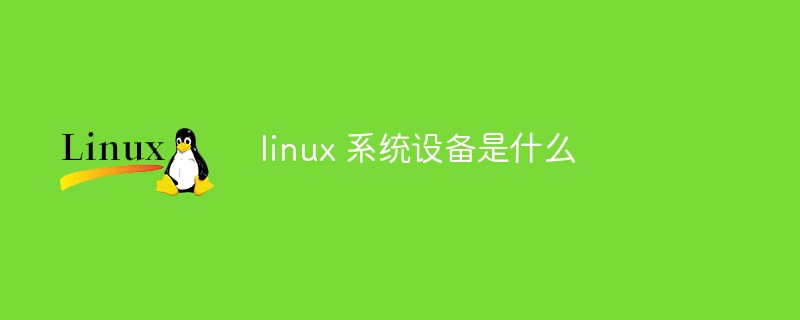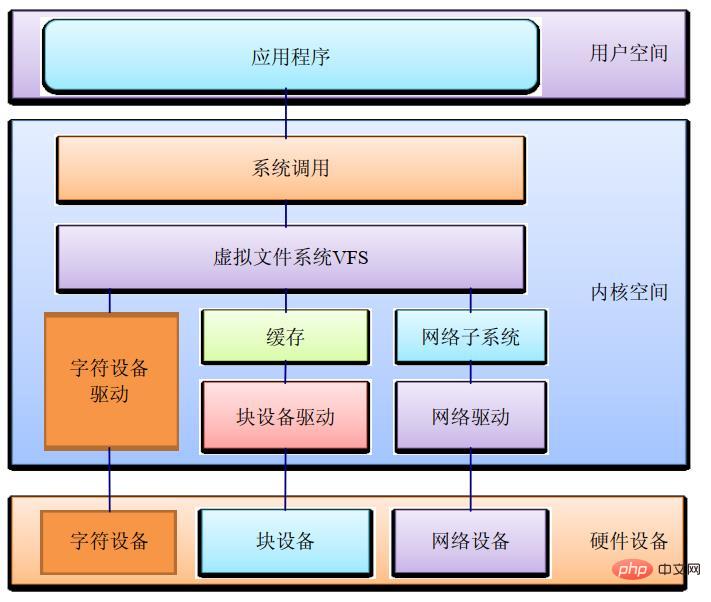What are linux system devices
Linux system devices are computer devices that use the Linux kernel and may be part of the GNU operating system; devices in the Linux system can be divided into three categories: character devices, block devices and network devices; among them, character devices can A device that is accessed like a stream. A block device is a device that must be accessed in blocks when performing a TO operation in a Linux system. A network device can be either a hardware device such as a network card or a pure software device such as a loopback device. .

#The operating environment of this tutorial: linux5.9.8 system, Dell G3 computer.
What are Linux system devices?
Linux devices or Linux-based devices are computer devices that use the Linux kernel and possibly some GNU operating systems. They tend to be minimalist and purpose-built, and may be environmentally friendly and produce less e-waste per unit.
What are the categories of Linux devices?
1. Linux devices
Devices in the Linux system can be divided into three categories: character devices, block devices and network devices.
Character device
A character device is a device that can be accessed like a byte stream. When a read or write request is made to a character device, the corresponding The IO operation occurs immediately. Many devices in the Linux system are character devices, such as character terminals, serial ports, keyboards, mice, etc. In embedded Linux development, the most common ones are character devices and drivers.
Block device
Block device is a device that must be accessed in blocks when performing TO operations in the Linux system. Block devices can be installed File system. The block device driver will use a piece of system memory as a buffer, so issuing read and write accesses to the block device does not necessarily result in hardware I/O operations immediately. Common block devices in Linux systems include hard disks, floppy drives, etc.
Network equipment
Network equipment can be either a hardware device such as a network card or a pure software device such as a loopback device. Network devices are driven by the Linux network subsystem and are responsible for sending and receiving data packets, rather than stream devices. Therefore, network devices do not have nodes in the Linux system file system. Access to network devices is generated through socket calls, rather than ordinary file operations such as open/closc and read/write.
2. The status of the driver in Linux
The driver is the bridge between the device and the user in the Linux system. In the Linux system, accessing the device must be operated through the device driver, and user programs cannot Directly operate the equipment. The relationship between hardware, drivers and user programs in the Linux system is shown in the figure.

The driver runs in the kernel space. User programs can only access and operate the hardware and data transferred by the hardware device through the system calls provided by the kernel, VFS and the driver. It must also go through the driver, VFS and system calls before it can be received by the user program. Therefore, device drivers are bridges and channels for applications to access system devices and transfer data.
Related recommendations: "Linux Video Tutorial"
The above is the detailed content of What are linux system devices. For more information, please follow other related articles on the PHP Chinese website!

Hot AI Tools

Undresser.AI Undress
AI-powered app for creating realistic nude photos

AI Clothes Remover
Online AI tool for removing clothes from photos.

Undress AI Tool
Undress images for free

Clothoff.io
AI clothes remover

Video Face Swap
Swap faces in any video effortlessly with our completely free AI face swap tool!

Hot Article

Hot Tools

Notepad++7.3.1
Easy-to-use and free code editor

SublimeText3 Chinese version
Chinese version, very easy to use

Zend Studio 13.0.1
Powerful PHP integrated development environment

Dreamweaver CS6
Visual web development tools

SublimeText3 Mac version
God-level code editing software (SublimeText3)

Hot Topics
 1671
1671
 14
14
 1428
1428
 52
52
 1329
1329
 25
25
 1276
1276
 29
29
 1256
1256
 24
24
 Linux Architecture: Unveiling the 5 Basic Components
Apr 20, 2025 am 12:04 AM
Linux Architecture: Unveiling the 5 Basic Components
Apr 20, 2025 am 12:04 AM
The five basic components of the Linux system are: 1. Kernel, 2. System library, 3. System utilities, 4. Graphical user interface, 5. Applications. The kernel manages hardware resources, the system library provides precompiled functions, system utilities are used for system management, the GUI provides visual interaction, and applications use these components to implement functions.
 vscode Previous Next Shortcut Key
Apr 15, 2025 pm 10:51 PM
vscode Previous Next Shortcut Key
Apr 15, 2025 pm 10:51 PM
VS Code One-step/Next step shortcut key usage: One-step (backward): Windows/Linux: Ctrl ←; macOS: Cmd ←Next step (forward): Windows/Linux: Ctrl →; macOS: Cmd →
 How to check the warehouse address of git
Apr 17, 2025 pm 01:54 PM
How to check the warehouse address of git
Apr 17, 2025 pm 01:54 PM
To view the Git repository address, perform the following steps: 1. Open the command line and navigate to the repository directory; 2. Run the "git remote -v" command; 3. View the repository name in the output and its corresponding address.
 How to run java code in notepad
Apr 16, 2025 pm 07:39 PM
How to run java code in notepad
Apr 16, 2025 pm 07:39 PM
Although Notepad cannot run Java code directly, it can be achieved by using other tools: using the command line compiler (javac) to generate a bytecode file (filename.class). Use the Java interpreter (java) to interpret bytecode, execute the code, and output the result.
 How to run sublime after writing the code
Apr 16, 2025 am 08:51 AM
How to run sublime after writing the code
Apr 16, 2025 am 08:51 AM
There are six ways to run code in Sublime: through hotkeys, menus, build systems, command lines, set default build systems, and custom build commands, and run individual files/projects by right-clicking on projects/files. The build system availability depends on the installation of Sublime Text.
 What is the main purpose of Linux?
Apr 16, 2025 am 12:19 AM
What is the main purpose of Linux?
Apr 16, 2025 am 12:19 AM
The main uses of Linux include: 1. Server operating system, 2. Embedded system, 3. Desktop operating system, 4. Development and testing environment. Linux excels in these areas, providing stability, security and efficient development tools.
 laravel installation code
Apr 18, 2025 pm 12:30 PM
laravel installation code
Apr 18, 2025 pm 12:30 PM
To install Laravel, follow these steps in sequence: Install Composer (for macOS/Linux and Windows) Install Laravel Installer Create a new project Start Service Access Application (URL: http://127.0.0.1:8000) Set up the database connection (if required)
 git software installation
Apr 17, 2025 am 11:57 AM
git software installation
Apr 17, 2025 am 11:57 AM
Installing Git software includes the following steps: Download the installation package and run the installation package to verify the installation configuration Git installation Git Bash (Windows only)




